|
|
|
Is Birdsong Music?: Outback Encounters with an Australian SongbirdHollis Taylor
Indiana University Press
2017
"Revolutionizing the way we think about the core values of music and human exceptionalism, Hollis Taylor takes us on an outback road trip to meet the Australian pied butcherbird. Recognized for their distinct timbre, calls, and songs, both sexes of this songbird sing in duos, trios, and even larger choirs, transforming their flute-like songs annually. While birdsong has long inspired artists, writers, musicians, and philosophers, and enthralled listeners from all walks of life, researchers from the sciences have dominated its study. As a field musicologist, Taylor spends months each year in the Australian outback recording the songs of the pied butcherbird and chronicling their musical activities. She argues persuasively in these pages that their inventiveness in song surpasses biological necessity, compelling us to question the foundations of music and confront the remarkably entangled relationship between human and animal worlds. Equal parts nature essay, memoir, and scholarship, Is Birdsong Music? offers vivid portraits of the extreme locations where these avian choristers are found, quirky stories from the field, and an in-depth exploration of the vocalizations of the pied butcherbird."
|
Buy from amazon.co.uk 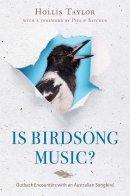
|
|
A Sweet, Wild Note: What We Hear When the Birds SingRichard Smyth
Elliott & Thompson
2017
"In this fascinating account, Richard Smyth asks what it is about birdsong that we so love. Exploring the myriad ways in which it has influenced literature, music, science and our very ideas of what it means to be British, Smyth's nuanced investigation shows that what we hear says as much about us, our dreams and desires, as it does about the birds and their songs. At a time when our birdsong is growing quieter, with fewer voices, more thinly spread, A Sweet, Wild Note is a celebration of the complex relationships between birds, people and the land; it is also a passionate call to arms lest our trees and hedgerows fall silent."
|
Buy from amazon.co.uk 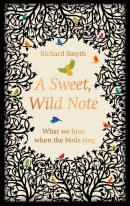
|
|
Beaks, Bones, and Bird Songs: How the Struggle for Survival Has Shaped Birds and Their BehaviorRoger J. Lederer
Timber Press
2016
"In Beaks, Bones, and Bird Songs ornithologist Roger Lederer guides the reader through the myriad, and often almost miraculous, things that birds do every day to merely stay alive. Like the goldfinch, who manages extreme weather changes by doubling the density of their plumage in winter. Or urban birds who navigate traffic through a keen understanding of posted speed limits. In engaging and accessible prose, Lederer shares how and why birds use their sensory abilities to see ultraviolet, find food without seeing it, fly thousands of miles without stopping, change their songs in noisy cities, navigate by smell, and much more. Roger Lederer has studied bird behavior for more than thirty years. In Beaks, Bones, and Bird Songs he shares this knowledge in an entertaining and eye-opening way that will be widely embraced by birders and nature lovers."
|
Buy from amazon.co.uk 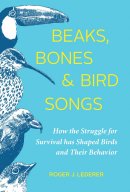
|
|
Listening to a Continent Sing: Birdsong by Bicycle from the Atlantic to the PacificDonald E Kroodsma
Princeton University Press
2016
"Join birdsong expert Donald Kroodsma on a ten-week, ten-state bicycle journey as he travels with his son from the Atlantic to the Pacific, lingering and listening to our continent sing as no one has before. On remote country roads, over terrain vast and spectacular, from dawn to dusk and sometimes through the night, you will gain a deep appreciation for the natural symphony of birdsong many of us take for granted. Come along and marvel at how expressive these creatures are as Kroodsma leads you west across nearly five thousand miles – at a leisurely pace that enables a deep listen. Listening to a Continent Sing is also a guided tour through the history of a young nation and the geology of an ancient landscape, and an invitation to set aside the bustle of everyday life to follow one's dreams. It is a celebration of flowers and trees, rocks and rivers, mountains and prairies, clouds and sky, headwinds and calm, and of local voices and the people you will meet along the way."
|
Buy from amazon.co.uk 
|
|
Birdsong, Speech, and Language: Exploring the Evolution of Mind and BrainEditor: Johan J Bolhuis and Martin Everaert
MIT Press
2013
"Scholars have long been captivated by the parallels between birdsong and human speech and language. In this book, leading scholars draw on the latest research to explore what birdsong can tell us about the biology of human speech and language and the consequences for evolutionary biology. They examine the cognitive and neural similarities between birdsong learning and speech and language acquisition, considering vocal imitation, auditory learning, an early vocalization phase ("babbling"), the structural properties of birdsong and human language, and the striking similarities between the neural organization of learning and vocal production in birdsong and human speech. After outlining the basic issues involved in the study of both language and evolution, the contributors compare birdsong and language in terms of acquisition, recursion, and core structural properties, and then examine the neurobiology of song and speech, genomic factors, and the emergence and evolution of language."
|
Buy from amazon.co.uk 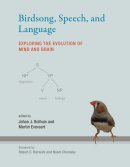
|
|
Birdwatching With Your Eyes Closed: An Introduction to BirdsongSimon Barnes
Short Books
2012
Revised paperback edition 2012
"Why do birds sing? What are they trying to say? Birdsong is not just about natural history. It is also about our history. We got melody from birds as we got rhythm from the womb. This vital book with a free podcast takes you from winter into deepest spring, teaching you how to recognise song after song as the chorus swells. You start with robin, and end up listening to nightingales. Along the way, you will learn the science of birdsong the difference between song and call, the physiology of songbirds, what birdsong tells us about evolution, and indeed the very beginnings of life itself. The aim is to give you a flying start in birdsong so that, after reading this book, you ll be listening to order, not chaos, to Bach, not white noise. You will be more aware of the wild world, and better able to understand it."
|
Buy h/b from amazon.co.uk 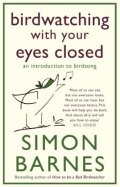
Buy p/b from amazon.co.uk

|
|
Birdsong by the Seasons: A Year of Listening to BirdsDonald Kroodsma
Houghton Mifflin Harcourt
2009
"Birdsong by the Seasons is a celebration of birdsong from January through December. The stories begin with a pileated woodpecker on New Year's Day; they unfold through the year, covering limpkins and scrub-jays in February in Florida, prairie birds in May, Scarlet Tanagers in July, and ending with a chorus of singing birds in Massachusetts just before Christmas. Readers get inside the mind of a scientist and see how answers only lead to more questions. Kroodsma provides a unique experience: with his gentle guidance, the pairing of sonagrams with the audio CDs make birdsong accessible and fascinating."
|
Buy from amazon.co.uk 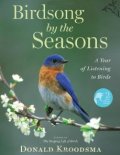
|
|
Vocal Communication in Birds and Mammals
Advances in the Study of Behavior, Volume 40
Chief editors: Marc Naguib, Vincent M. Janik
Editors: Klaus Zuberbuhler, Nicola S. Clayton
Academic Press
2009
"Advances in the Study of Behavior was initiated over 40 years ago to serve the increasing number of scientists engaged in the study of animal behavior. That number is still expanding. This thematic volume, Vocal Communication in Birds and Mammals, makes another important "contribution to the development of the field" by presenting theoretical ideas and research to those studying animal behavior and to their colleagues in neighboring fields."
|
Buy from amazon.co.uk 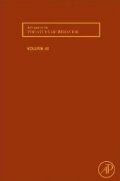
|
|
Bird Song: Biological Themes and VariationsC.K. Catchpole and J.B. Slater
Cambridge University Press
2nd edition
2008
"Bird song is one of the most remarkable and impressive sounds in the natural world, and has inspired not only students of natural history, but also great writers, poets and composers. Extensively updated from the first edition, the main thrust of the book is to suggest that the two main functions of song are attracting a mate and defending territory. It shows how this evolutionary pressure has led to the amazing variety and complexity we see in the songs of different species throughout the world. Writing primarily for students and researchers in animal behavior, the authors review over 1000 scientific papers and reveal how scientists are beginning to unravel and understand how and why birds communicate with the elaborate vocalizations we call song. Highly illustrated throughout and written in straightforward language, Bird Song also holds appeal for amateur ornithologists with some knowledge of biology."
|
Buy from amazon.co.uk 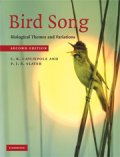
|
|
Neuroscience of BirdsongEditor: H. Philip Zeigler, Peter Marler
Cambridge University Press
2008
"Speech has long been thought of as a uniquely defining characteristic of humans. Yet song birds, like humans, communicate using learned signals (song, speech) that are acquired from their parents by a process of vocal imitation. Both song and speech begin as amorphous vocalizations (subsong, babble) that are gradually transformed into an individualized version of the parent's speech, including dialects. With contributions from both the founding forefathers and younger researchers who represent the future of this field, this book provides a comprehensive summary of birdsong neurobiology, and identifies the common brain mechanisms underlying this achievement in both birds and humans. Written primarily for advanced graduates and researchers, there is an introductory overview covering song learning, the parallels between language and birdsong and the relationship between the brains of birds and mammals; subsequent sections deal with producing, processing, learning and recognizing song, as well as with hormonal and genomic mechanisms."
|
Buy from amazon.co.uk 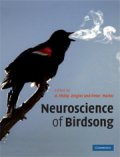
|
|
The Physics of BirdsongGabriel B Mindlin and Rodrigo Laje
Springer-Verlag
2005
"In recent years birdsong has developed into an extremely interesting problem for researchers in several branches of the scientific community. The reason is that of the approximately 10,000 species of birds known to exist, some 4000 share with humans (and just a few other species in the animal kingdom) a remarkable feature: their acquisition of vocalization requires a certain degree of exposure to a tutor. Between the complex neural architecture involved in the process and the song itself, stands a delicate apparatus that the bird must control with incredible precision. This book deals with the physical mechanisms at work in the production of birdsong, the acoustic effects that the avian vocal organ is capable of generating, and the nature of the neural instructions needed to drive it. The book provides fascinating reading for physicists, biologists and general readers alike."
|
Buy from amazon.co.uk 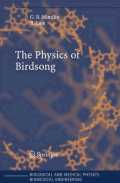
|
|
The Singing Life of Birds: The Art and Science of Listening to BirdsongDonald E. Kroodsma
Houghton Mifflin
2005
"Listen to birds sing as you've never listened before, as the world-renowned birdsong expert Donald Kroodsma takes you on personal journeys of discovery and intrigue. Read stories of wrens and robins, thrushes and thrashers, warblers and whip-poor-wills, bluebirds and cardinals, and many more bird. Learn how each acquires its songs, how songs vary from bird to bird and place to place, how some birds' singing is especially beautiful or ceaseless or complex, how some do not sing at all, how the often quiet female has the last word, and why. Hear a baby wren and the author's own daughter babble as each learns its local dialect. Listen to the mockingbird by night and by day and count how many different songs he can sing. Marvel at the exquisite harmony in the duet of a wood thrush as he uses his two voice boxes to accompany himself. Feel the extraordinary energy in the songs just before sunrise as dawn's first light sweeps across this singing planet. Hear firsthand the unmistakable evidence that there are not one but two species of marsh wrens and two species of winter wrens in North America. Learn not only to hear but to see birds sing in the form of sonagrams, as these visual images dance across the pages while you listen to the accompanying CD."
|
Buy from amazon.co.uk 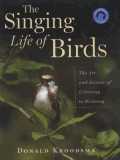
|
|
Social Influences on Vocal DevelopmentEditor: Charles T. Snowdon & Martine Hausberger
Cambridge University Press
2005
"For at least 30 years, there have been close parallels between studies of birdsong development and those of the development of human language. Both song and language require species-specific stimulation at a sensitive period in development and subsequent practice through subsong and plastic song in birds and babbling in infant humans leading to the development of characteristic vocalisations for each species. This book illustrates how social interactions during development can shape vocal learning and extend the sensitive period beyond infancy and how social companions can induce flexibility even into adulthood. Social companions in a wide range of species including birds and humans but also cetaceans and nonhuman primates play important roles in shaping vocal production as well as the comprehension and appropriate usage of vocal communication."
|
Buy from amazon.co.uk 
|
|
Why Birds Sing: One Man's Quest to Solve an Everyday MysteryDavid Rothenberg
Penguin Books
2005
"The richness and variety of birdsong is both a scientific mystery and a source of wonder. David Rothenberg has a unique approach to this fascinating subject, combining the latest scientific research with a deep understanding of musical beauty and form. Can the standard explanations of territoriality or sexual selection account for so many species' astonishing inventiveness and devotion to singing? Whether playing the clarinet with the white-crested laughing thrush in Pittsburgh or jamming in the Australian winter breeding grounds of the Albert's lyrebird, Rothenberg touches the heart and soul of birdsong, offering an intimate look at the most lovely of natural phenomena."
|
Buy from amazon.co.uk 
|
|
Birdsong: A Natural HistoryDon Stap
Scribner
2005
"Following one of the world's experts on birdsong from the woods of Martha's Vineyard to the tropical forests of Central America, Don Stap brings to life the quest to unravel an ancient mystery: Why do birds sing and what do their songs mean? We quickly discover that one question leads to another. Why does the chestnut-sided warbler sing one song before dawn and another after sunrise? Why does the brown thrasher have a repertoire of two thousand songs when the chipping sparrow has only one? And how is the hermit thrush able to sing a duet with itself, producing two sounds simultaneously to create its beautiful, flutelike melody? Stap's lucid prose distills the complexities of the study of birdsong and unveils a remarkable discovery that sheds light on the mystery of mysteries: why young birds in the suborder oscines - the "true songbirds" - learn their songs but the closely related suboscines are born with their songs genetically encoded. As the story unfolds, Stap contemplates our enduring fascination with birdsong, from ancient pictographs and early Greek soothsayers, who knew that bird calls represented the voices of the gods, to the story of Mozart's pet starling."
|
Buy from amazon.co.uk 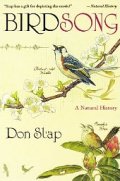
|
|
Nature's Music: The Science of BirdsongPeter R Marler and Hans Slabbekoorn
Academic Press
2004
"Nature's Music brings together some of the worlds experts on birdsong, to review the advances that have taken place in our understanding of how and why birds sing, what their songs and calls mean, and how they have evolved. All contributors have strived to speak, not only to fellow experts, but also to the general reader. The result is a book of readable science, richly illustrated with recordings and pictures of the sounds of birds. Bird song is much more than just one behaviour of a single, particular group of organisms. It is a model for the study of a wide variety of animal behaviour systems, ecological, evolutionary and neurobiological. Bird song sits at the intersection of breeding, social and cognitive behaviour and ecology. Contents: 1.Science and birdsong: the good old days; 2.Vocal fighting and flirting: the functions of birdsong; 3.Learning to sing; 4.The diversity and plasticity of birdsong; 5.Bird calls: a cornucopia for communication; 6.Singing in the wild: the ecology of birdsong; 7.Audition: can birds hear everything they sing?; 8.Brains and birdsong; 9.How birds sing and why it matters; 10.Performance limits on birdsong; 11.Birdsong and conservation; 12.Grey parrots: learning and using speech; 13.Singing, socializing, and the music effect.
|
Buy from amazon.co.uk 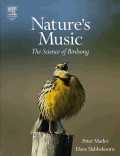
|
|
Behavioural Neurobiology of BirdsongEdited by Philip H Zeigler and Peter Marler
Annals Of The New York Academy Of Sciences 1016
New York Academy of Sciences
2003
"Many features of bird song have made it an increasingly fruitful model for research on a number of important problems in behavioural neurobiology. Among these features are: the stereotyped and quantifiable nature of song behaviour; the many similarities between the acquisition of bird song and of human speech; and the identification and increasingly precise characterization of a central neural circuit dedicated to song. These features have engaged the attention of researchers on species-typical behaviour, communication, behavioural development, central sensory processing, motor learning, sensorimotor control, neurogenesis, and neuronal plasticity. This text offers an overview of findings in the bird song system that have had a major impact on neuroscience research, and have fundamentally altered our concepts of brain function. The 32 papers constitute the proceedings of a conference on The Behavioural Neurobiology of Bird Song, held in New York in 2002."
|
Buy from amazon.co.uk 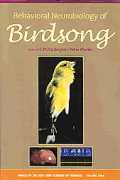
|
|
Bird Song: Biological Themes and VariationsC.K. Catchpole and J.B. Slater
Cambridge University Press
2003
"This book explores the study of bird song from the biological viewpoint, reviewing the literature written on the subject and considering its intricate nature. It is written with a wide readership in mind so that, while undergraduate and postgraduate students of biology may gain particularly from it, both professional biologists interested in bird behaviour and amateur ornithologists with some knowledge of biology will also find it a mine of information."
|
Buy from amazon.co.uk 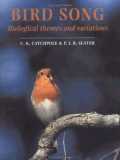
|
|
Bird Sounds: How and Why Birds Sing, Call, Chatter, and ScreechBarry Kent MacKay
Stackpole Books
2003
"A thorough and engaging examination of the variety of sounds birds make, from the familiar singing of songbirds and the hammering of woodpeckers to the harsh cacklings of crows. The hows and whys of bird vocalisation, regional variation and speciation, and communication among species are discussed. Describes both native and exotic bird behaviour and includes the latest research - all illustrated with full-colour paintings by the author."
|
Buy from amazon.co.uk 
|
|
Songs, Roars & Rituals: Communication in Birds, Mammals & Other AnimalshLesley J. Rogers and Gisella Kaplan
Harvard University Press
2001
"From the calling macaw and the roaring lion to the dancing lyrebird, animals all around us can be heard and seen communicating with each other and, occasionally, with us. Why they do so, what their utterances mean, and how much we know about them are the subject of "Songs, Roars, and Rituals." This is a concise, yet comprehensive, introduction to the complexities of communication in animals. Rogers and Kaplan take us on an exciting journey through communication in the animal world, offering insights on how animals communicate by sight, sound, smell, touch, and even electrical signaling. They explore a wide variety of communication patterns in many species of mammals and birds and discuss in detail how communication signals evolved, how they are learned, and what song and mimicry may mean. An up-to-date account of the science of animal communication, this book also considers modern concepts (such as that of deceptive communication) and modern controversies, primarily those surrounding the evolution of human language and the use of symbolic language by apes. It concludes with a thought-provoking look at the future of communication between humans and animals."
|
Buy from amazon.co.uk 
|
|
Ecology and Evolution of Acoustic Communication in BirdsEditors: Donald E. Kroodsma
Cornell University Press
1996
"Twenty-five invited papers reviewing the contributing ornithologists' current research in birds' acoustic communication with an ecological and evolutionary focus, and also identifying the areas they feel will dominate future research efforts. The discussions center around the areas of vocal development, vocal repertoires, vocal variation in time and space, the control and recognition of vocalizations, and the behavior of communicating. The specific topics are anything but boring and include such diverse offerings as bird communication in a noisy world, how birds develop their songs, and the use of interactive playback to understand bird behavior." Contents:
- Ecology of Passerine Song Development - Donald E. Kroodsma
- Eco-gen-actics: A Systems Approach to the Ontogeny of Avian Communication - Meredith West, Andrew King
- Nature and Its Nurturing in Avian Vocal Development - Luis F. Baptista
- Birdsong Learning in the Laboratory and Field - Michael D. Beecher
- Acquisition and Performance of Song Repertoires: Ways of Coping with Diversity and Versatility - Dietmar Todt, Henrike Hultsch
- Acoustic Communication in Parrots: Laboratory and Field Studies of Budgerigars, Melopsittacus undulatus - Susan M. Farabaugh, Robert J. Dooling
- Categorization and the Design of Signals: The Case of Song Repertoires - Andrew G. Horn, J. Bruce Falls
- Comparative Analysis of Vocal Repertoires, with Reference to Chickadees - Jack P. Hailman, Millicent Sigler Ficken
- Acoustic Communication in a Group of Nonpasserine Birds, the Petrels - Vincent Bretagnolle
- The Population Memetics of Birdsong - Alejandro Lynch
- Song Traditions in Indigo Buntings: Origin, Improvisation, Dispersal, and Extinction in Cultural Evolution - Robert B. Payne
- Vocalizations and Speciation of Palearctic Birds - Jochen Martens
- Acoustic Differentiation and Speciation in Shorebirds - Edward H. Miller
- A Comparison of Vocal Behavior among Tropical and Temperate Passerine Birds - Eugene S. Morton
- Study of Bird Sounds in the Neotropics: Urgency and Opportunity - Donald E. Kroodsma, Jacques M. E. Vielliard, F. Gary Stiles
- The Neuroethology of Birdsong - Eliot A. Brenowitz, Donald E. Kroodsma
- Organization of Birdsong and Constraints on Performance - Marcel M. Lambrechts
- Bird Communication in the Noisy World - Georg M. Klump
- Sex Differences in Song Recognition - Laurene Ratcliffe, Ken Otter
- Vocal Recognition of Neighbors by Territorial Passerines - Philip Kraft Stoddard
- Using Interactive Playback to Study How Songs and Singing Contribute to Communication about Behavior - W. John Smith
- Dynamic Acoustic Communication and Interactive Playback - Torben Dabelsteen, Peter K. McGregor
- Communication Networks - Peter K. McGregor, Torben Dabelsteen
- The Dawn Chorus and Other Diel Patterns in Acoustic Signaling - Cynthia A. Staicer, David A. Spector, Andrew G. Horn
- Song and Female Choice - William A. Searcy, Ken Yasukawa
- Appendix. Natural Sound Archives: Guidance for Recordists and a Request for Cooperation - Donald E. Kroodsma, Gregory F. Budney, Robert W. Grotke, Jacques M. E. Vielliard, Sandra L. L. Gaunt, Richard Ranft, Olga D. Veprintseva.
|
Buy from amazon.co.uk 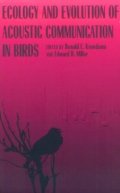
|
|
Born to Sing: An Interpretation and World Survey of Bird SongC. Hartshorne
Indiana University Press
1992 (orig publ 1973)
"One of the most comprehensive, entertaining studies of bird vocalisations available. It offers a global survey of modes of singing, encompassing more than 5,000 species of singing birds, with special analyses of nearly 200 species with highly developed songs."
|
Buy from amazon.co.uk 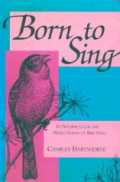
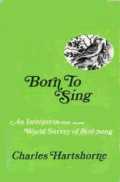
|
|
Bird Song and Bird BehaviorDonald J. Borror
Dover Publications
1989
"A classic work examining bird song as both a means of identification and study of behavior, and citing 72 species and 51 songs. Includes 50-minute cassette and 64pp. manual with sound spectographs and illustrations of 21 birds."
|
Buy from amazon.co.uk 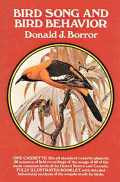
|
|
Acoustic Communication in Birds, Volume 1: Production, Perception & Design Features of SoundsD. E. Kroodsma and E. H. Miller
Academic Press
1983
|
Buy from amazon.co.uk |
|
Acoustic Communication in Birds, Volume 2: Song Learning and Its ConsequencesD. E. Kroodsma and E. H. Miller
Academic Press
1983
|
Buy from amazon.co.uk 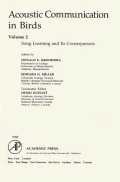
|
|
Vocal Communication in BirdsClive K. Catchpole
Edward Arnold
1979
A 72 page study. A volume in the Studies In Biology series.
|
Buy from amazon.co.uk |
|
Bird Sounds and their MeaningRosemary Jellis
BBC Publications
1977 (revised 1984)
"This book introduces the whole subject of bird sound. It will stimulate anyone interested in birds to make as much sense of what they hear as of what they see and gives an overview of the subject that will be valuable to workers in allied fields. With a foreword by Frank Fraser Darling and drawings by Derek Goodwin."
|
Buy from amazon.co.uk 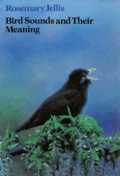
|
|
Bird SoundsGehard A. Thielcke
University of Michigan Press
1976
|
Buy from amazon.co.uk 
|
|
Discovering Bird SongE. A. Armstrong
Shire Publications
1975
A 92 page study which includes songograms.
|
Buy from amazon.co.uk 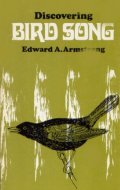
|
|
A Study Of Bird SongE. A. Armstrong
Dover Publications
1973
This is an enlarged and revised edition of the book that was originally published in 1963.
|
Buy from amazon.co.uk 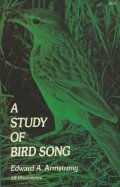
|
|
Duetting and Antiphonal Song in Birds: Its Extent and SignificanceW. H. Thorpe in collaboration with J. Hall-Craggs, B. Hooker, T. Hooker and R. Hutchison
Behaviour, Supplement No. 18
E. J. Brill
1972
|
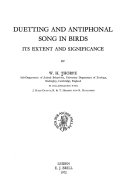 |
|
Bird Vocalizations: Their Relations to Current Problems in Biology and PsychologyEditor: R.A. Hinde
Cambridge University Press
1969
Essays presented to W.H. Thorpe.
|
Buy from amazon.co.uk 
|
|
Bird Song: Acoustics and PhysiologyCrawford H. Greenewalt
Smithsonian
1968
|
Buy from amazon.co.uk 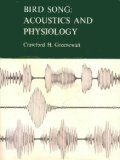
|
|
A Study Of Bird SongE. A. Armstrong
Oxford University Press
1963
The first extensive review of bird vocalizations. Chapter headings include: Bird Utterance as Language; The Structure and Components of Bird Song; The Development and Learning of Song; Sub-Song; Vocal Mimicry; Song Dialects and the Relationship of Vocalisation to Speciation; Territorial Song and Related Forms of Song; Song-flight and Non-Vocal Song; Song and the Annual Cycle; Female Song; Duetting and Corporate Song; The Influence of Light, Weather and Temperature on Song; Song and Adaptations to Habitat; and Bird Song as Art and Play.
An enlarged edition of this book was published in 1973.
|
Buy from amazon.co.uk 
|
|
Bird-Song: The Biology of Vocal Communication and Expression in BirdsW.H. Thorpe
Cambridge Monographs in Experimental Biology
Cambridge University Press
1961
|
Buy from amazon.co.uk 
|
|
Bird Song and New Zealand Song BirdsJohannes C. Andersen
Whitcombe and Tombs
1926
From the introduction: "It has often been questioned whether any similarity exists between the song of birds and the song of human beings:
whether birds modulate their voices in intervals agreeing with those that build up the scale of the octave. That it is possible for them to do so is evident, since they are able to slur from one note into another, through the full octave, in the same way that the human voice is able to do. Yet most writers, if they theorize at all upon the subject of bird-song, contend that birds do not sing with regular or constant intervals, and 'would not deign to be fettered with a scale'".
|
 |
|